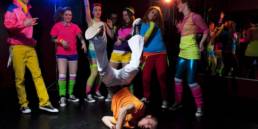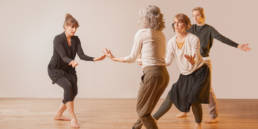If you’re familiar with Cumbia, the mention of the word may instantly evoke images of hot summer nights, groups of people laughing together with children running around, the occasional mother brushing or braiding her daughter’s hair as the boys run around playing, with soft sounds of Cumbia music in the background.
Cumbia is Colombia’s most popular dance, being its national dance. Although not widely known in the previous years, it is starting to resurface internationally once again thanks to bands such as Bomba Estereo. What’s there to not love about it – it’s extremely fun, passionate, and expressive. So buckle up and start the journey of learning all about Cumbia and how to dance the Colombian style!
Cumbia Origins
Cumbia dance is a partnered dance popular in Colombia, but also in Chile and Mexico. It is a mix and blend of many dances of African, European, and other indigenous cultures. This does not come as a surprise because Colombia itself is a melting pot of these and many other cultures. Cumbia originated on the Caribbean coast of Colombia (more specifically, the town of San Basilio) where it developed as an African courtship dance. This dance had elements of European cultures as well, and the cumbia music involved both African and European indigenous instruments.
Although widely described as “Salsa”, Cumbia music is actually considered the predecessor of all Latin music. Not only does it predate other types of Latin music, but it is also said to have been a strong influencing factor on Salsa and Samba.
Nowadays, Cumbia is becoming popular in North America as well and is being used as an alternative to Salsa music, and many dancers actually dance Salsa to Cumbia music. It is also being danced from Mexico to Argentina in Central American states.
How Do You Dance Cumbia?
Cumbia is traditionally danced at night, in a pair as it is a partnered dance. Typically, the couples dance in a circle around musicians producing the Cumbia music. The men move in zig-zag motions around the women, while the women make shuffling movements while holding candles in bundles wrapped into colored foulards.
However, this is the traditional form of the dance. Nowadays, dancers dance Cumbia at carnivals, and while the foulards have remained a part of the dance, candles are no longer widely used.
Cumbia Music
While you may not have access to an actual Cumbia music band, you can use music reproduction equipment to play Cumbia music for you to dance to at home or in a dance studio.
Whether you’re a dance trainer or an individual trying to learn a really cool dance, you can always use a subwoofer to play and listen to Cumbia music with good bass and crisp audio quality. Alternately, if you just want to listen to some Cumbia music at home or dance to video instructions in front of your TV, you can use a soundbar. And finally, if you’re dedicated to dancing and listening to music on the street, or perhaps at a backyard with a group of friends, you should definitely consider a boombox for your Cumbia dance party.
So, put on a cute South-America inspired dress, and get to dancing! Maybe even make those Cumbia dance handkerchiefs pop with different colored nails on each finger and be sure you’ll mesmerize the crowd – whether you’re performing on stage, or at home for your dog.


